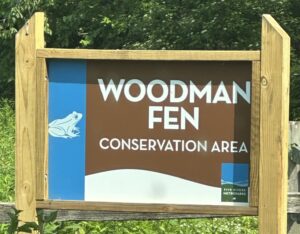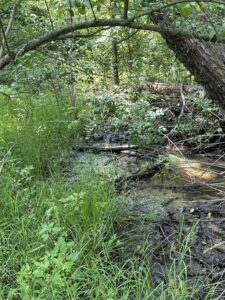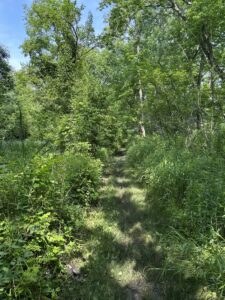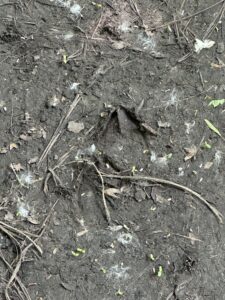Birding around Dayton, OH Part 2
 Woodman Fen. 2409 Newcastle Drive, Dayton. https://www.metroparks.org/places-to-go/woodman-fen/
Woodman Fen. 2409 Newcastle Drive, Dayton. https://www.metroparks.org/places-to-go/woodman-fen/
Some birding places are easy to find – this one would not be so easy. Luckily its address worked on the GPS in my phone which took us straight to the small parking lot. This fen is part of the city park system of Dayton. It is a natural area is of decent size – 33 acres – but it is surrounded on all sides by a neighborhood of houses placed fairly close together with lots of paved streets, sidewalks, and curbs. Within the fen there is a single .75 mile loop trail. From the trail, it is rare to see any sight of the surrounding neighborhood, but there is some noise – particularly the closer you are to the parking lot at either end of the loop. In our case it was a very energetic, barking dog and a lawn mower. No matter where you are, it is hard to be away from people’s noise pollution in city parks.
I have birded in many city parks and these parks in Dayton are about average for noise pollution. Most of the time it does not interfere with hearing birds sing and call. The exception is that Dayton has its own international airport with big jets departing and landing at regular intervals and they fly low over these parks. But the real noisemakers are from the U.S. Air Force at Wright Patterson Air Force Base which is right there. A huge transport plane flew low over this park when we were about halfway around the loop and it was absolutely deafening in its loudness. However, the birds did not seem to miss a beat. They were singing and calling before they were completely drowned out and were singing and calling as the plane with all its noise receded. Birds really are adaptable – more adaptable than I am.

So what exactly is a fen? From the online Oxford dictionary: A fen is a low and marshy or frequently flooded area of land whose soil is primarily peat. The difference between a bog and a fen is that although both are peat, the water source of a bog is rain or snow – precipitation. And the water simply does not drain away as it normally would leaving the soil saturated at all times. Bogs are often acidic which is why they are such good places to look for wild blueberries and cranberries. The water source for a fen is an underground source such as a very high water table, or constant run-off from surface water – flooding. And the soil remains saturated.
The loop trail at Woodman Fen was well maintained and level, but most of the trail was slightly muddy to fairly wet. No standing water, but definitely squishy in a lot of sections. And we expected that – after all, this is a fen!

In yesterday’s blog, I told you how much I have always liked wetlands and that includes fens – they are such interesting places with such interesting plants. And you can see water percolating up from the ground all over a fen. Woodman Fen is about 33 acres and has been restored. Dozens and dozens of native plants that thrive in fens were added to this area and everything we saw seemed quite healthy and alive as we walked along. There is a short boardwalk that leads to the center of the fen, but unfortunately for us, the boardwalk was closed. Boardwalks offer great access into otherwise inaccessible areas of wetlands, marshes, bogs, and fens.
The website for Woodman Fen claims this is one of the best birding spots in all of Dayton. Here is our list from about an hour walk on the .75 mile loop trail. And a note on that trail – Cleon and I laughed that we cannot deny that we are getting older, but we think this loop trail is longer than .75 mile. We think it is about a mile. And on the website it is listed at .6 of a mile. I have been a hiker all my life and Cleon has been a hiler in the 30 years he has been married to me. We generally think the miles on trail markers are approximate – sort of a ballpark figure. So keep that in mind – this .75 of a mile seems long. But the walking is cushioned and level – great on the feet! And as it was yesterday at Aullman Audubon, we heard all these birds singing – we only actually saw a few. Big trees, all fully leafed out, and thick undergrowth. It was just simply a lovely walk!
Orchard Oriole Common Grackle Red-winged Blackbird
Wood Thrush Carolina Wren Northern Flicker
Red-bellied Woodpecker Gray Catbird Eastern Meadowlark
Rough-winged Swallow Northern Cardinal Rose-breasted Grosbeak
Song Sparrow House Finch American Crow
Blue-gray Gnatcatcher Eastern Wood-Pewee Carolina Chickadee*
Tufted Titmouse Mourning Dove Blue Jay
House Sparrow Brown-headed Cowbird
*Neither Cleon nor I can identify whether a chickadee we observe is a Carolina or a Black-capped. For us, these birds look alike, sound alike, and these 2 birds have overlapping ranges in southern Ohio. (I discuss this at length in my ebook COMMON SONGBIRDS AND RAPTORS IN YOUR YARD, NEIGHBORHOOD, AND FAVORITE PARK.)


Neither Cleon or I used insect repellent. I most often do not as I generally am not overly bothered by bugs – swarms of gnats being the exception. I just hate them in my hair, buzzing around my ears, in my eyes, and up my nose! Cleon seems to be a bug attractor – I tease him that is because of his sweet nature. Actually it is probably because the man could live on pie and ice cream! He normally uses insect repellent – especially when we are hiking in wet areas in the summer. But he did not on this trail and neither of us were bothered. However, I would advise that if you walk this trail, have insect repellent with you – it is a fen and it is wet. Insects thrive here.
I posted 2 videos from our walk at this fen. Watch, listen, and enjoy!

